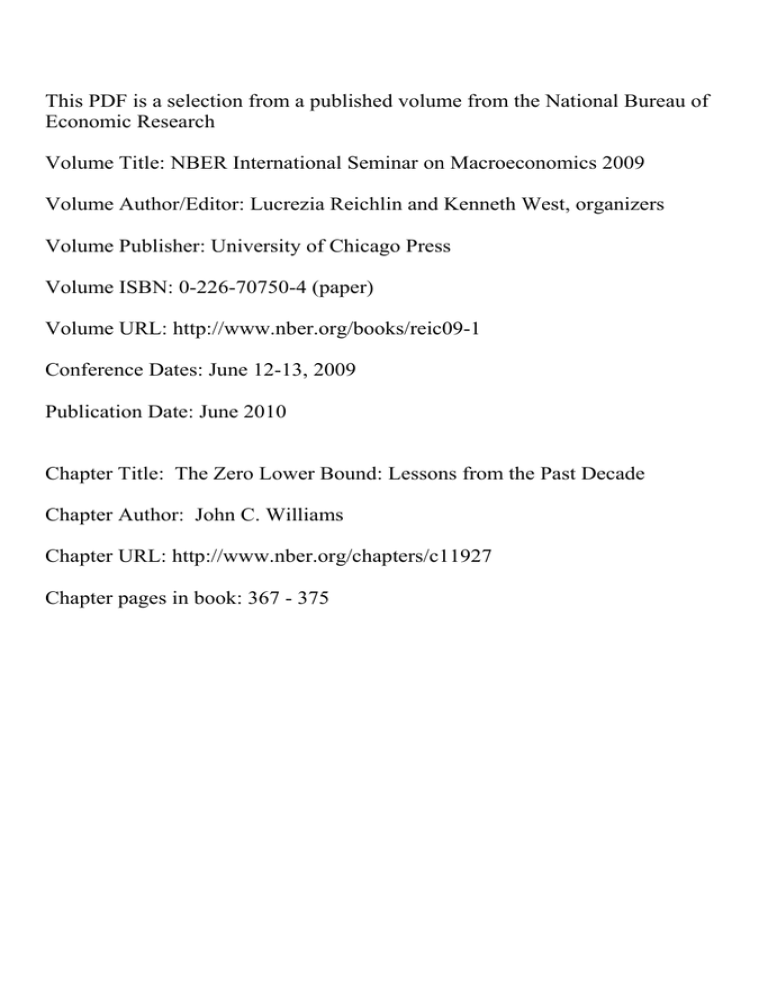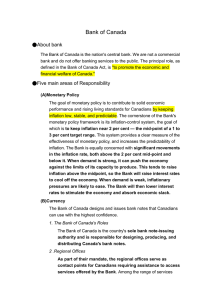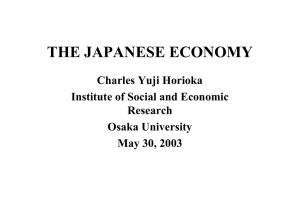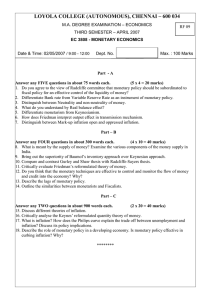
This PDF is a selection from a published volume from the National Bureau of
Economic Research
Volume Title: NBER International Seminar on Macroeconomics 2009
Volume Author/Editor: Lucrezia Reichlin and Kenneth West, organizers
Volume Publisher: University of Chicago Press
Volume ISBN: 0-226-70750-4 (paper)
Volume URL: http://www.nber.org/books/reic09-1
Conference Dates: June 12-13, 2009
Publication Date: June 2010
Chapter Title: The Zero Lower Bound: Lessons from the Past Decade
Chapter Author: John C. Williams
Chapter URL: http://www.nber.org/chapters/c11927
Chapter pages in book: 367 - 375
The Zero Lower Bound: Lessons
from the Past Decade
John C. Williams, Federal Reserve Bank of San Francisco
Japan’s encounter with deflation and near‐zero‐interest short‐term interest rates in the 1990s led to a surge in research on the implications
of the zero lower bound (ZLB) on nominal interest rates for monetary
policy around the end of that decade. Based on model simulations, the
literature at that time identified a number of key implications of the
ZLB (see Orphanides and Wieland [2000], Reifschneider and Williams
[2000, 2002], Eggertsson and Woodford [2003], and references therein).
First, with low inflation targets of the kind followed by many central
banks, the ZLB will frequently be a binding constraint on monetary policy. That is, Japan’s example is not an outlier but rather a harbinger for the
future. Second, at inflation targets of 1% or lower, lowering the inflation
target comes at a cost of higher variability of output and inflation, although the effects on inflation variability are relatively small. This analysis
provides an argument for maintaining a positive inflation target cushion
above 1%. Third, in rare instances of severe prolonged recessions accompanied by deflation, standard open market operations will be insufficient
to bring the inflation rate back to target, and alternative sources of stimulus
to the economy, such as fiscal policy, will be needed. Fourth, central banks
can significantly reduce the effects of the ZLB on macroeconomic stability
by modifying their policy actions and communication to the public when
the ZLB threatens to constrain policy. Specifically, policies that cut rates
aggressively when deflation is a risk and promise to temporarily target
a higher rate of inflation following episodes where the ZLB binds were
found to greatly reduce the effects of the ZLB in model simulations.
In the decade since this research was initiated, the ZLB has gone from a
theoretical issue applying to Japan to one that plagues many industrialized economies. Indeed, an era of overwhelming confidence in monetary policy’s power to tame the business cycle while delivering low and
stable inflation has been replaced by fears that the global economy could
© 2010 by the National Bureau of Economic Research. All rights reserved.
978‐0‐226‐70749‐5/2010/2009‐0084$10.00
368
Williams
dive into a great depression with monetary policy powerless to stop it.
The experiences of the past decade provide an opportunity to critically reevaluate the earlier research on the effects of the ZLB and the
design of effective monetary policy strategies in the presence of the
ZLB. The first part of this note examines the evidence regarding key assumptions used in the research on the ZLB and the effects of the ZLB on
major industrial economies in light of the experience of the past decade.
The note concludes with a discussion of directions for further research on
the ZLB and monetary policy.
The evidence provides clear support for the first conclusion from research: the ZLB has proven frequently to be a binding constraint on monetary policy for central banks that target low levels of inflation. Reifschneider
and Williams (2002) find that with a 2% inflation target, roughly in line
with the practices of major central banks, a calibrated version of the Taylor
rule hits the ZLB about 10% of the time in simulations of the Federal Reserve Board’s FRB/US model. Figure 1 shows the policy rate for a number of major industrialized economies. Japan’s policy rate was below 1%
throughout this period. In 2003, the U.S. federal funds rate was lowered
to 1% in response to very low inflation and slow recovery from recession.
Although the ZLB was not a binding constraint for Federal Reserve policy at that time, concerns that it could become so were high on policy
makers’ minds. Monetary policy strategy during this period was highly
Fig. 1.
Monetary policy rates
Panel Discussion
369
attuned to issues related to the ZLB and the possibility of deflation. The
ZLB became a concern again in 2008. By early 2009, it had became a binding constraint for central banks in many large industrialized countries,
with policy rates cut to below 1% in all of the countries shown in the figure. These episodes suggest a relatively high frequency of the ZLB binding, consistent with the predictions from the model simulations.
A second notable conclusion from the research described above is
that inflation is not much affected by the presence of the ZLB, a prediction that appears to receive some support from the data in the current
global downturn. Figure 2 shows core measures of inflation for the
same countries included in the previous figure. It is, of course, still early
days in the current global recession, but core measures of inflation have
yet to fall much from their precrisis levels. In each case, inflation has
edged down, but, at least so far, these declines have been quite modest
and well within the ranges of variation seen in the past decade. Indeed,
in the United States, professional forecasters expect core inflation to go
up over the next 2 years, not down, despite the very elevated forecasts
for unemployment (Williams 2009).
A key factor explaining the stability of inflation during the past decade
has been the anchoring of inflation expectations in most major industrial economies. Figure 3 shows forecasts of inflation expected to prevail
6–10 years in the future over the past decade. Except for Japan, these
long‐run inflation forecasts have been remarkably stable over this period, despite sizable swings in commodity prices and major recessions.
Fig. 2.
Core inflation rates
370
Fig. 3.
Williams
Long‐run inflation expectations. Source: Consensus Economics, Inc., 2001–9
In the case of the United States, Williams (2006a) finds that the behavior
of inflation in the United States during the past 15 years provides strong
evidence supporting the assumption of well‐anchored expectations, an
assumption that underlies most research on the ZLB. In contrast, if inflation expectations are “adaptive,” that is, they are primarily linked to
recent past inflation, then the ZLB can give rise to a devastating deflationary spiral (see, e.g., Reifschneider and Williams [2000] for a discussion).
In Japan, which underwent a prolonged period of deflation starting in
the 1990s, long‐run inflation expectations eventually slipped toward
zero early in the current decade, but they rebounded in 2004 and have
remained relatively stable since then.
It is impossible to know for certain whether standard open market
operations alone would have been sufficient to restore macroeconomic
equilibrium in the current situation. The severity of the financial and
economic crisis and the constraint on monetary policy imposed by the
ZLB led several central banks to undertake unconventional monetary
policies and governments to take actions to support financial sectors
and to institute large‐scale fiscal stimulus programs. Major central banks
have taken unprecedented actions, including providing enormous quantities of liquidity to banks and other financial institutions, purchasing
wider sets of assets than usual, and in some cases dramatically increasing
their balance sheets.
Panel Discussion
371
Indeed, a striking development during the past decade has been the
active use of well‐timed discretionary countercyclical fiscal policy in
many countries. Japan aggressively used fiscal policy with the goal of
stimulating the economy during the 1990s and the current recession.
Auerbach (2009) documents the increased use of discretionary countercyclical fiscal policy in the United States in the most recent two recessions
in the United States. In the current recession, the International Monetary
Fund (IMF 2009) expects discretionary fiscal policy to average 1% of GDP
in the G‐20 economies over the period of 2008–10, above and beyond
automatic stabilizers and measures to support the financial sector.
The active use of discretionary fiscal policy was excluded from consideration in research on the ZLB. For example, Reifschneider and Williams
(2000) assume that automatic stabilizers and other endogenous responses of fiscal variables function normally but that no discretionary
fiscal policy is allowed except in extreme downturns. The experience of
the past decade suggests that this assumption is too stringent. In this respect, by ignoring the ways in which fiscal policy is used to substitute for
monetary policy, this research may have overstated the likely effects of
the ZLB on macroeconomic performance.
Arguably, most major central banks have followed several policy prescriptions of the research summarized above, both in terms of actions
and communications. The Federal Reserve’s response to the slow recovery and deflation scare early in this decade incorporated key recommendations from this research. The policy rate was cut to very low levels and
was raised only gradually to minimize the risk of deflation. In addition,
the Federal Open Market Committee (FOMC) actively used its policy
statements to communicate in qualitative terms its expectation for the
contour of the future path of policy (see Rudebusch and Williams
2008). In August 2003, the FOMC stated that “policy accommodation
can be maintained for a considerable period.” In January 2004, the FOMC
said that “it can be patient in removing its policy accommodation,” and
later that year, as rate hikes appeared imminent, it said that “policy accommodation can be removed at a pace that is likely to be measured.”
This communication appeared to help shape market expectations of future federal funds rates.1
Although falling short of a promise to raise inflation temporarily
above its long‐run goal, as recommended by research, the FOMC’s
communication did suggest a bias toward preferring too‐high inflation
over too‐low inflation at the time. In fact, the long‐run inflation expectations and the longer‐run break‐even inflation rate derived from the
difference between nominal and indexed Treasury securities both edged
372
Williams
up during the time of these FOMC statements. In its March 9, 2006, policy
statement, the Bank of Japan followed a broadly similar strategy in communicating its plan to withdraw monetary accommodation. In particular, it stated that “there will be a period in which the overnight call rate
is at effectively zero percent, followed by a gradual adjustment in the
light of developments in economic activity and prices.”2 At the same
time, the Bank of Japan took the additional step of providing quantitative
guidance regarding its long‐run inflation goal.
Major central banks cut rates sharply following the intensification of
the crisis in late 2008, in keeping with the policy prescriptions from research. Although the reaction times differed across major central banks,
reflecting in part differences in economic conditions, the sharpness of the
rate cuts and the low levels to which rates were cut indicate that no major
central bank perceived a benefit from “keeping its powder dry.”
As in the earlier episode, the FOMC sought to communicate its patience in removing accommodation by stating that it anticipated that
“economic conditions are likely to warrant exceptionally low levels of
the federal funds rate for an extended period.”3 The Bank of Canada
has been even more explicit about its policy intentions. Its April 21,
2009, statement declared: “Conditional on the outlook for inflation,
the target overnight rate can be expected to remain at its current level
until the end of the second quarter of 2010 in order to achieve the inflation
target.”4 Still, no major central bank has followed the leads of the Reserve
Bank of New Zealand, the Norges Bank, and the Riksbank by providing
quantitative forecasts of its policy rate in order to better clarify its intentions (see Rudebusch and Williams [2008] for an analysis of publishing interest rate projections). And no major central bank has committed
itself to the goal of temporarily attaining inflation rates above the long‐
run target.
The current crisis has proven that monetary policy makers have far
more tools in their toolkits than the short‐term interest rate, which was
the focus of most model‐based research on the ZLB. Indeed, the ongoing
crisis is in some ways an atypical test case for the ZLB because many of
the disturbances to the economy have been centered in the financial sector. This fact created an opportunity for central banks and governments
to create programs aimed directly at alleviating dislocations and reducing risks spreads in credit and financial markets. In the United States,
these interventions have included facilities supporting short‐term funding markets, securitization markets, and purchases of agency debt and
mortgage‐backed securities. In a “normal” recession not associated
with a financial crisis, these tools may be of little consequence and
Panel Discussion
373
the ability of central banks to offset macroeconomic disturbances may
be more limited.
In important respects, the research begun a decade ago on the ZLB
has held up reasonably well to the test of time. Not surprisingly, the
experiences of the past decade have exposed a number of shortcomings
in the first generation of research studying the ZLB and have highlighted areas in need of further research. Some of these weaknesses,
such as the lack of a role for credit and financial frictions, afflict many
models used for monetary policy analysis. Others have particular relevance for the ZLB, and these are the focus of the remainder of this note.
Given the heightened role of discretionary fiscal policy in practice,
more theoretical and empirical work on discretionary fiscal policy in
conjunction with the ZLB is needed. Eggertsson and Woodford (2006)
make progress in this direction by analyzing the joint problem of optimal
monetary policy and taxation. This paper emphasizes the use of tax policy to reduce supply when the ZLB is constraining monetary policy. But
there are channels by which fiscal policy can affect demand as well as
supply, and these call for further study.
The global nature of the current recession highlights the need for incorporating international linkages in analysis of the ZLB. Svensson
(2001) emphasized the role of exchange rate depreciation as part of
monetary policy strategy in the face of the ZLB. This analysis assumed
that only the home country was facing the ZLB. In the current episode,
all major economies are in the same boat, and Svensson’s approach is
not feasible for all countries to follow. Coenen and Wieland (2003) and
Bodenstein, Erceg, and Guerrieri (2009) study the ZLB in multicountry
frameworks, and further analysis using open economy models is
needed.
Finally, more research on alternative monetary policy strategies that
cope with the ZLB is needed. Several central banks have undertaken
policies to modify the size and composition of their balance sheets with
the goal of bringing down long‐term interest rates. The effectiveness and
proper implementation of such strategies remain controversial and in
need of serious study. Major central banks have not tried targeting the
shorter end of the yield curve (1‐ and 2‐year yields). Such a strategy, analyzed by McGough, Rudebusch, and Williams (2005), is a natural extension of standard open market operations that target the overnight rate
and can be easily coordinated with central bank communication of the
future path of policy.
A key finding from research is that policies that promise higher‐than‐
usual inflation following an episode of the ZLB constraining policy are
374
Williams
highly effective at mitigating the stabilization costs of the ZLB. In particular, policies that target an exogenously rising price level rather than
an inflation rate perform very well in the presence of the ZLB. Despite
this, central banks appear to be very leery of openly following such a
strategy. Interestingly, there is some evidence that Fed policy already
contains elements of such a strategy. Gorodnichenko and Shapiro
(2007) find that Fed policy in recent decades possesses key features of
price‐level targeting policies. In addition, the behavior of U.S. inflation
over the past 15 years is consistent with price‐level‐targeting monetary
policy (Orphanides and Williams 2009; Williams 2009). Nonetheless,
even if the Fed is following a policy of this kind, the public may not fully
understand monetary policy strategy once the ZLB constrains policy actions. In that case, the benefits of the policy, which rely heavily on expectations of future policy actions, may be reduced (Williams 2006b). This
potential for confusion argues for effectively pairing appropriate monetary policy actions and words to align the public’s expectations of future
policy with those of the central bank.
Endnotes
The opinions expressed are those of the author and do not necessarily reflect the views
of the management of the Federal Reserve Bank of San Francisco or anyone else in the
Federal Reserve System.
1. Board of Governors of the Federal Reserve System, “FOMC Statement,” August 12,
2003, http://www.federalreserve.gov/boarddocs/press/monetary/2003/20030812/
default.htm; “FOMC Statement,” January 28, 2004, http://www.federalreserve.gov/
boarddocs/press/monetary/2004/20040128/default.htm; and “FOMC Statement,”
May 4, 2004, http://www.federalreserve.gov/boarddocs/press/monetary/2004/
20040504/default.htm.
2. Bank of Japan, “Change in the Guidelines for Money Market Operations,” Monetary
Policy Releases, March 9, 2009, http://www.boj.orjp/en/type/release/zuiji_new/
k060309.htm.
3. Board of Governors of the Federal Reserve System, “FOMC Statement,” April 29,
2009, http://www.federalreserve.gov/newsevents/press/monetary/20090429a.htm.
4. Bank of Canada, press release, April 21, 2009, http://www.banqueducanada.ca/en/
press/prgen09.html.
References
Auerbach, Alan J. 2009. “Implementing the New Fiscal Policy Activism.” Working paper ( January), Department of Economics, University of California,
Berkeley.
Bodenstein, Martin, Christopher J. Erceg, and Luca Guerrieri. 2009. “The Effects
of Foreign Shocks When U.S. Interest Rates Are at Zero.” Working paper
(March), International Finance Division, Board of Governors of the Federal
Reserve, Washington, DC.
Panel Discussion
375
Coenen, Guenter, and Volker Wieland. 2003. “The Zero‐Interest Rate Bound and
the Role of the Exchange Rate for Monetary Policy in Japan.” Journal of Monetary Economics 50, no. 5:1071–1101.
Eggertsson, Gauti, and Michael Woodford. 2003. “The Zero Interest‐Rate Bound
and Optimal Monetary Policy.” Brookings Papers on Economic Activity, no. 1:
139–211.
———. 2006. “Optimal Monetary and Fiscal Policy in a Liquidity Trap.” NBER
International Seminar on Macroeconomics 2004:75–131.
Gorodnichenko, Yuriy, and Matthew D. Shapiro. 2007. “Monetary Policy When
Potential Output Is Uncertain: Understanding the Growth Gamble of the
1990s.” Journal of Monetary Economics 54, no. 4:1132–62.
IMF (International Monetary Fund). 2009. “The State of Public Finances: Outlook and Medium‐Term Policies after the 2008 Crisis.” Working paper, Fiscal
Affairs Department, International Monetary Fund, Washington, DC.
McGough, Bruce, Glenn D. Rudebusch, and John C. Williams. 2005. “Using a
Long‐Term Interest Rate as the Monetary Policy Instrument.” Journal of Monetary Economics 52, no. 5:855–79.
Orphanides, Athanasios, and Volker Wieland. 2000. “Efficient Monetary Policy
Design Near Price Stability.” Journal of the Japanese and International Economies
14 (December): 327–65.
Orphanides, Athansios, and John C. Williams. 2009. “Monetary Policy Mistakes
and the Evolution of Inflation Expectations.” Photocopy (March), Federal Reserve Bank of San Francisco.
Reifschneider, David, and John C. Williams. 2000. “Three Lessons for Monetary
Policy in a Low Inflation Era.” Journal of Money, Credit and Banking 32,
no. 4:936–66.
———. 2002. “FOMC Briefing” ( January), Board of Governors of the Federal
Reserve System, Washington, DC.
Rudebusch, Glenn D., and John C. Williams. 2008. “Revealing the Secrets of the
Temple: The Value of Publishing Central Bank Interest Rate Projections.” In
Asset Prices and Monetary Policy, ed. John Y. Campbell, 247–84. Chicago: University of Chicago Press.
Svensson, Lars E. O. 2001. “The Zero Bound in an Open Economy: A Foolproof
Way of Escaping from a Liquidity Trap.” Monetary and Economic Studies 19,
no. S1:277–312.
Williams, John C. 2006a. “Inflation Persistence in an Era of Well‐Anchored Inflation Expectations.” In Federal Reserve Bank of San Francisco Economic Letter,
no. 2006‐27 (October 13).
———. 2006b. “Monetary Policy in a Low Inflation Economy with Learning.”
In Monetary Policy in an Environment of Low Inflation: Proceedings of the Bank of
Korea International Conference, 2006, 199–228. Seoul: Bank of Korea.
———. 2009. “The Risk of Deflation.” In Federal Reserve Bank of San Francisco
Economic Letter, no. 2009‐12 (March 27).









